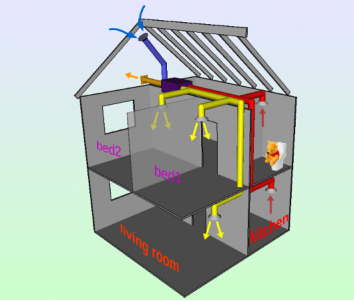MVHR + Overfloor heating vs. just underfloor heating
I realise this may not fit the category brilliantly, but bear with me.
We have 8kWp East/West Solar PV (no battery) being installed imminently, and a pre-existing 12kW ASHP which was fitted in a bit of a rush towards the end of the RHI period last year. The intention to revisit the rest of the heating system in the house (specifically the emitters) once we had a better idea what our renovation plans were going to look like. As such, our radiators on the ground floor are almost all undersized (and ancient), many of them are at least 40 years old and in pretty bad shape. We also have many heat losses that could be considerably less (and will be once our renovations are complete).
The house is a 1950s detached house with a slab floor. We now have plans in place and have been giving packs to builders to tender.
As part of the plans, we had hoped to dig up the slab and retrofit wet underfloor heating in order to maximise the thermal mass as an energy store and make the most of whatever solar we can get in the colder months.
Unfortunately, it's looking to be prohibitively expensive (£40k+, maybe more depending on what the test holes unearth).
As such, we are looking at alternatives, and overfloor heating has been mooted, probably with chunky tiles on top to maximise the thermal mass.
Does anyone have any real world experience of underfloor vs. overfloor, specifically with low flow temperatures and air source heat pumps? I'm a bit of a loss to know what to do. On the one hand, the materials for overfloor are considerably more expensive, on the other, the labour is considerably less, I'm more interested to know the effect it will have on efficiency, or if anyone has any pearls of wisdom on the best floor covering to use to maximise the thermal mass.
My hunch is that we are better off spending £40k on overfloor heating + MVHR + chunky tiles than £40k on just a new slab and UFH and chunky tiles.
Thoughts?
Posted by: @cashbackI realise this may not fit the category brilliantly, but bear with me.
We have 8kWp East/West Solar PV (no battery) being installed imminently, and a pre-existing 12kW ASHP which was fitted in a bit of a rush towards the end of the RHI period last year. The intention to revisit the rest of the heating system in the house (specifically the emitters) once we had a better idea what our renovation plans were going to look like. As such, our radiators on the ground floor are almost all undersized (and ancient), many of them are at least 40 years old and in pretty bad shape. We also have many heat losses that could be considerably less (and will be once our renovations are complete).
The house is a 1950s detached house with a slab floor. We now have plans in place and have been giving packs to builders to tender.
As part of the plans, we had hoped to dig up the slab and retrofit wet underfloor heating in order to maximise the thermal mass as an energy store and make the most of whatever solar we can get in the colder months.
Unfortunately, it's looking to be prohibitively expensive (£40k+, maybe more depending on what the test holes unearth).
As such, we are looking at alternatives, and overfloor heating has been mooted, probably with chunky tiles on top to maximise the thermal mass.
Does anyone have any real world experience of underfloor vs. overfloor, specifically with low flow temperatures and air source heat pumps? I'm a bit of a loss to know what to do. On the one hand, the materials for overfloor are considerably more expensive, on the other, the labour is considerably less, I'm more interested to know the effect it will have on efficiency, or if anyone has any pearls of wisdom on the best floor covering to use to maximise the thermal mass.
My hunch is that we are better off spending £40k on overfloor heating + MVHR + chunky tiles than £40k on just a new slab and UFH and chunky tiles.
Thoughts?
To maximise overall efficiency with a heat pump, it is necessary to operate with the lowest possible LWT.
To be able to utilise a low LWT, it is necessary to reduce heat loss as much as possible, and have heat emitters providing the highest heating capacity. UFH is normally deemed to give the highest heating capacity, but this will vary dependent upon the distance between loops and the area covered. Larger radiators may offer the same heating capacity at lower cost, or one could consider fan assisted radiators, which although more expensive, can increase heating capacity without physically increasing the size.
An alternative could be fan coil units, think AC, to provide additional heat energy.
There are 'wet' UFH options for renovation properties which are installed on top of the existing floor.
Nu-heat offer some, but it's worthwhile looking around for others online.
Is this what you're calling over-floor heating?
The point is, you end up with a radiating surface that is still a lot larger than you would've achieved by hanging 'radiators' on the wall.
The efficiency depends on the insulation you place below the heating pipe loops.
You really don't want to lose heat into the existing floor slab.
I have a self-installed MVHR system.
I got it primarily to allow ventilation rather than for heating the house.
However, I've placed a small 150x150mm radiator in the fresh-air outlet to the rooms (yellow in diagram below).
This gets supplied with the same water at 45°C which also goes to the UFH loops.
That's enough to deliver 'warmed' air during the winter months.
The main factor when installing MVHR is the upheaval of running 100mm pipes everywhere.
It's pretty mundane work, easily achievable with common sense.
Do you really want to pay a tradesman to do that part of the job for you?
Or shall I point you in the direction of suppliers who stock the required components?
Save energy... recycle electrons!
@cashback I guess you have a number of considerations which you are probably juggling. Eg. Loss of Door and ceiling height with an overlay heating installation, Existing un-insulated floor slab, thermal envelope, solar gain and existing thermal mass of walls. Etc.
With a new slab you will have whatever headroom you need, proper under slab insulation and a full thermal mass store. You could also have polished concrete finish to avoid extra cost of floor coverings.
The overlay approach might be a handy retrofit but you may have an insulated layer between the older slab, so not quite such a good thermal store.
£40,000 (and a lot less) would buy you a lot of radiators if you’ve got an easy option to run the pipework. They may need to be operated at a higher temperature than UF. Size of rad might be a visual issue unless you go all out for feature statement rads.
Posted by: @sunandairEg. Loss of Door and ceiling height with an overlay heating installation,
Yes I had wondered about this, however we have a mixture of decrepit parquet flooring, carpet underlay and carpet which equates to more or less the same if we were to remove the lot and replace it with OFH and tiles
Posted by: @sunandairYou could also have polished concrete finish to avoid extra cost of floor coverings.
This was also a consideration. From what I understand, the costs are much of a muchness as the cost to polish and seal the concrete isn't far off the cost of a good quality tile anyway. Plus there's the other risk of cracking (visually speaking) and ongoing maintenance of a polished concrete floor.
Posted by: @sunandair£40,000 (and a lot less) would buy you a lot of radiators if you’ve got an easy option to run the pipework. They may need to be operated at a higher temperature than UF. Size of rad might be a visual issue unless you go all out for feature statement rads.
I can't stand radiators. They're a pain when it comes to furnishing a room, and I've never found a feature radiator worth making a feature out of. The pre-existing slab means we are somewhat restricted to either surface mounted pipework (ew), or chasing pipes in to walls, which feels risky having uncovered and lived through several leaky, buried, pipes. I'm less concerned about UFH since one contiguous length of underfloor heating pipe is much more resilient than buried copper joints!
Posted by: @transparentThere are 'wet' UFH options for renovation properties which are installed on top of the existing floor.
Nu-heat offer some, but it's worthwhile looking around for others online.
Is this what you're calling over-floor heating?
Yes, there's also Wundertherm, and others. Their efficacy seems to be much of a muchness.
Posted by: @transparentI've placed a small 150x150mm radiator in the fresh-air outlet to the rooms (yellow in diagram below).
This gets supplied with the same water at 45°C which also goes to the UFH loops.
That's enough to deliver 'warmed' air during the winter months.
Oh interesting! I'd heard of MVHR with cooling, but not MVHR with heating. At the moment I'm seeing MVHR as an option if a new slab is not an option.
Posted by: @transparentThe main factor when installing MVHR is the upheaval of running 100mm pipes everywhere.
This is achievable, I have figured out pipe runs, and much of it will be exposed
Posted by: @transparent
It's pretty mundane work, easily achievable with common sense.Do you really want to pay a tradesman to do that part of the job for you?
Or shall I point you in the direction of suppliers who stock the required components?
My primary concern is not being an impediment or a lynchpin for other parts of the renovation, I'd sooner pay the pros to do it (and budget for it accordingly) than create delays with other rtades because my DIY estimate of how long it'll take, and doing it around a day job in evenings and weekends is off.
OK. Understood.
So have a look at the pipe diameter being used in these differing over-floor heating (can I call it OFH?) solutions.
And then look here at the calculations I produced a couple of days ago for someone else.
Manufacturers wanting to offer 'thin floor' OFH will obviously try to save height by reducing the pipe diameter.
But there's good reason why 16mm outer-dia has become the norm.
Nor do you have to stick solely to the radiation plate solutions which they offer.
You can use aluminium cooking foil pretty effectively if the specs are getting tight !
Save energy... recycle electrons!
Posted by: @transparentOK. Understood.
So have a look at the pipe diameter being used in these differing over-floor heating (can I call it OFH?) solutions.
And then look here at the calculations I produced a couple of days ago for someone else.
Manufacturers wanting to offer 'thin floor' OFH will obviously try to save height by reducing the pipe diameter.
But there's good reason why 16mm outer-dia has become the norm.Nor do you have to stick solely to the radiation plate solutions which they offer.
You can use aluminium cooking foil pretty effectively if the specs are getting tight !
Curiously, when we had our heat loss survey for the heat pump, I asked the surveyor to specs for UFH, which he duly did, but there's no mention of the assumed thermal mass nor pipe diameter, just pipe spacing.
Oh interesting! I'd heard of MVHR with cooling, but not MVHR with heating. At the moment I'm seeing MVHR as an option if a new slab is not an option.
Google 'MVHR and heat pump', you will find quite a number of systems available.
- 26 Forums
- 2,356 Topics
- 53.4 K Posts
- 662 Online
- 6,017 Members
Join Us!
Worth Watching
Latest Posts
-
RE: Octopus Cosy Heat Pump Owners & Discussion Thread
@andrewj Seeing they deleted both threads with the pict...
By HarrisonC , 5 hours ago
-
RE: Who's your electricity provider and what's your tariff?
@mars I think your commentary is very fair and balanc...
By JamesPa , 6 hours ago
-

RE: External pipework insulation
That's great advice @transparent... thank you. @david...
By Mars , 7 hours ago
-
RE: Advice on internal circulation pump noise
Thanks @mikefl - I'll maybe have a look at the lock-shi...
By jtg , 8 hours ago
-

RE: Heat Pump Heats the House… But It’s Not Cosy. Emitter Changes or System Tweak?
@toodles interesting suggestion, thanks. I will try to...
By GrahamF , 8 hours ago
-
RE: Mitsubishi Ecodan Auto Adaption trial to stop cycling.
The interval you talk of, i think, will be 60min for an...
By F1p , 12 hours ago
-

RE: Electricity price predictions
Does anyone have a current graphic, visual or breakdown...
By Mars , 15 hours ago
-
Agree with @majordennisbloodnok on the setbacks. We hav...
By ChandyKris , 1 day ago
-
RE: New Fogstar 15.5kWh upright solution
It is a matter of luck. 2ith Fogstar "instructions", to...
By Batpred , 1 day ago
-

RE: Speedcomfort radiator fans
@deltona the way the links were added broke the page. A...
By Mars , 1 day ago
-

RE: Setback savings - fact or fiction?
I agree! Even more so if we get an answer! But the chal...
By cathodeRay , 1 day ago
-

RE: Refrigerant R32, is it now banned in the EU from 1st Jan 2027 for monobloc ASHPs?
This has been delayed from what I believe to be this ye...
By dgclimatecontrol , 2 days ago
-
RE: Are We Sleepwalking Into Another Race to the Bottom?
this is why I provided current flow temperatures in the...
By ksim , 2 days ago
-

RE: Why Millions of UK Homes Struggle With Heat Pumps
There's many homes that would be quite a disruption for...
By dgclimatecontrol , 2 days ago
-
RE: Ecodan unable to hit legionella target temp - what's the consensus?
@rhh2348 ...maybe this option is what you want? Alter...
By benson , 2 days ago
-

RE: Free Ecoheat Heat Pump Install
@old_scientist This does make the unit smaller as the b...
By dgclimatecontrol , 2 days ago
-
RE: Ecodan - Legionella Operation Time and Target Temperature
@old_scientist hiya mate, did you ever get to the botto...
By 9jwr9 , 2 days ago
-
RE: Configuring third party dongle for Ecodan local control
@majordennisbloodnok I think the HPDHD diagnosis may be...
By Sheriff Fatman , 2 days ago





